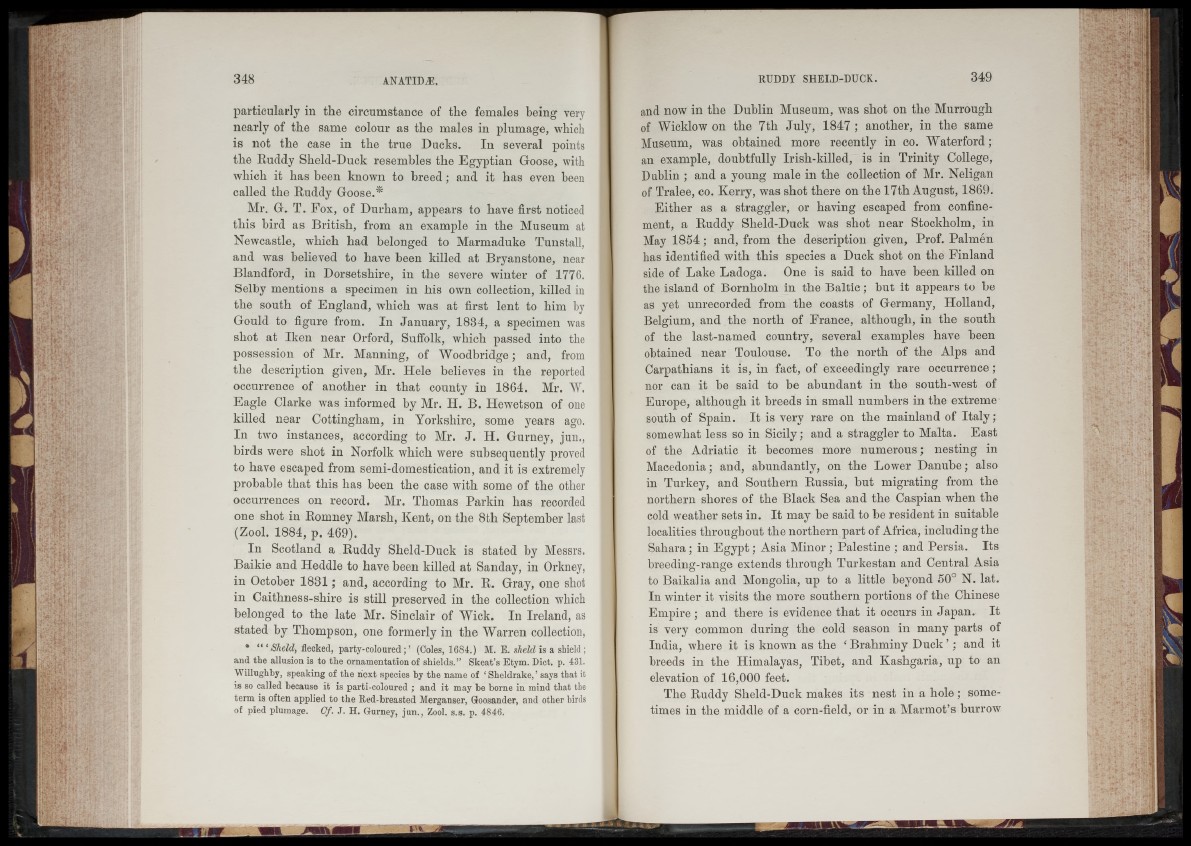
particularly in tlie circumstance of the females being very
nearly of the same colour as the males in plumage, which
is not the case in the true Ducks. In several points
the Ruddy Sheld-Duck resembles the Egyptian Goose, with
which it has been known to breed; and it has even been
called the Ruddy Goose.*
Mr. G. T. Fox, of Durham, appears to have first noticed
this bird as British, from an example in the Museum at
Newcastle, which had belonged to Marmaduke Tunstall,
and was believed to have been killed at Bryanstone, near
Blandford, in Dorsetshire, in the severe winter of 1776.
Selby mentions a specimen in his own collection, killed in
the south of England, which was at first lent to him by
Gould to figure from. In January, 1834, a specimen was
shot at Iken near Orford, Suffolk, which passed into the
possession of Mr. Manning, of Woodbridge; and, from
the description given, Mr. Hele believes in the reported
occurrence of another in that county in 1864. Mr. W.
Eagle Clarke was informed by Mr. H. B. Hewetson of one
killed near Cottingham, in Yorkshire, some years ago.
In two instances, according to Mr. J. H. Gurney, jun.,
birds were shot in Norfolk which were subsequently proved
to have escaped from semi-domestication, and it is extremely
probable that this has been the case with some of the other
occurrences on record. Mr. Thomas Parkin has recorded
one shot in Romney Marsh, Kent, on the 8th September last
(Zool. 1884, p. 469).
In Scotland a Ruddy Sheld-Duck is stated by Messrs.
Baikie and Heddle to have been killed at Sanday, in Orkney,
in October 1831; and, according to Mr. R. Gray, one shot
in Caithness-shire is still preserved in the collection which
belonged to the late Mr. Sinclair of Wick. In Ireland, as
stated by Thompson, one formerly in the Warren collection,
* “ *Sheld, flecked, party-coloured;’ (Coles, 1684.) M. E. sheld is a shield ;
and the allusion is to the ornamentation of shields.” Skeat’s Etym. Diet. p. 431.
Willughby, speaking of the next species by the name of ‘Sheldrake,’ says that it
is so called because it is parti-coloured ; and it may be borne in mind that the
term is often applied to the Red-breasted Merganser, Goosander, and other birds
of pied plumage. Cf. J. H. Gurney, jun., Zool. s.s. p. 4846.
and now in the Dublin Museum, was shot on the Murrough
of Wicklow on the 7tli July, 1847 ; another, in the same
Museum, was obtained more recently in co. Waterford;
an example, doubtfully Irish-killed, is in Trinity College,
Dublin ; and a young male in the collection of Mr. Neligan
of Tralee, co. Kerry, was shot there on the 17th August, 1869.
Either as a straggler, or having escaped from confinement,
a Ruddy Sheld-Duck was shot near Stockholm, in
May 1854; and, from the description given, Prof. Palmen
has identified with this species a Duck shot on the Finland
side of Lake Ladoga. One is said to have been killed on
the island of Bornholm in the Baltic; but it appears to be
as yet unrecorded from the coasts of Germany, Holland,
Belgium, and the north of France, although, in the south
of the last-named country, several examples have been
obtained near Toulouse. To the north of the Alps and
Carpathians it is, in fact, of exceedingly rare occurrence ;
nor can it be said to be abundant in the south-west of
Europe, although it breeds in small numbers in the extreme
south of Spain. It is very rare on the mainland of Italy;
somewhat less so in Sicily; and a straggler to Malta. East
of the Adriatic it becomes more numerous; nesting in
Macedonia; and, abundantly, on the Lower Danube; also
in Turkey, and Southern Russia, but migrating from the
northern shores of the Black Sea and the Caspian when the
cold weather sets in. It may be said to be resident in suitable
localities throughout the northern part of Africa, including the
Sahara ; in Egypt; Asia Minor; Palestine ; and Persia. Its
breeding-range extends through Turkestan and Central Asia
to Baikalia and Mongolia, up to a little beyond 50° N. lat.
In winter it visits the more southern portions of the Chinese
Empire ; and there is evidence that it occurs in Japan. It
is very common during the cold season in many parts of
India, where it is known as the ‘ Braliminy Duck ’ ; and it
breeds in the Himalayas, Tibet, and Kashgaria, up to an
elevation of 16,000 feet.
The Ruddy Sheld-Duck makes its nest in a hole; sometimes
in the middle of a corn-field, or in a Marmot’s burrow